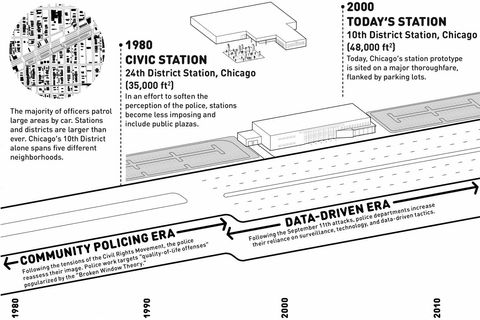2016 Americas Prize

Polis Station: Toward a Community-Centered Police Station
Studio Gang Architects
Chicago, IL, USA
September 2015
PRIMARY AUTHOR
Studio Gang Architects
CONTRIBUTING AUTHOR
CLIENT
PHOTOGRAPHER
OBJECTIVE
Polis Station offers a set of ideas that can help transform urban police stations into neighborhood investments that strengthen their communities. It explores questions about the typology of police stations and the role of architecture and design in rebuilding communities, ultimately proposing that police stations should be reoriented toward their communities to become sites of social connection where officers and neighbors can casually and informally interact. The proposal takes the form of a series of steps (both physical and programmatic) that can be taken to activate the spaces of policing and demonstrates how these steps could play out in a real-life setting by engaging with an existing station in Chicago’s 10th District. Informed by historical research, data analysis, and community engagement, Polis Station addresses an American problem yet speaks to tensions that translate beyond cultural or geographic boundaries. This real-life setting offered an opportunity in which to develop and test a set of architectural ideas exploring how 21st century policing might be applied in today’s urban environment.
CONTEXT
Widespread outrage and protests over recent acts of police violence in the United States have prompted a renewed national conversation on policing reform. Polis Station seeks to contribute to this critical dialogue by exploring how design can help people imagine changes in police-community relations. In December 2014, as a result of a series of high-profile incidents, President Obama convened the Task Force for 21st Century Policing. The Task Force engaged law enforcement officials, technical advisors, youth and community leaders, and nongovernmental organizations through a transparent public process. Based on information gathered during this process, the Task Force developed six “pillars” that structure recommendations for reforming policing today and in the future. These recommendations, released to the public in May 2015, address short- and long-term actions needed to rethink the state of policing. What the recommendations do not address, however, is the potential inherent in the physical spaces of policing, and especially the space of the police station, to rebuild the trust that is sorely lacking between police officers and citizens. Polis Station is intended to support these recommendations and provide a bridge between policy and public space, translating the six pillars into architecture and urban design. The Polis Station process involves researching past and present conditions to understand the national and political context, engaging many different people representing varied perspectives, and speculating through design to imagine a new future.
PERFORMANCE
Transforming police stations into full-service community centers can improve public safety and enhance both social connectivity and the economic strength of the surrounding neighborhood. Police stations are strategically located within communities and are therefore posed to offer crucial services that people need and desire. Simple interventions into existing stations, such as co-locating social services, offering access to job training or space for public gathering in or near the Polis Station, can improve communication, efficiency, and access to resources. With overlapping functions, opportunities abound for collaborative partnerships between law enforcement and local community institutions. By reconfiguring the space of the station along with new programming, including computer lab, law library, nutritionist, day care, mental health services, and an expanded community room, the Police Station becomes the Polis Station. As a small step toward proof of concept, the project transformed underutilized parking lot at the 10th District station into a half-court playspace. By providing safe, shared outdoor recreational space on police property, this intervention demonstrates the power of play as it creates overlap between the worlds of police officers and neighbors. Polis Station is essentially the process that brings community members to the table to rethink the design of our shared community assets. Ultimately, it serves as an open-source model for cities across the country, to be adopted and implemented in response to their specific community context.











